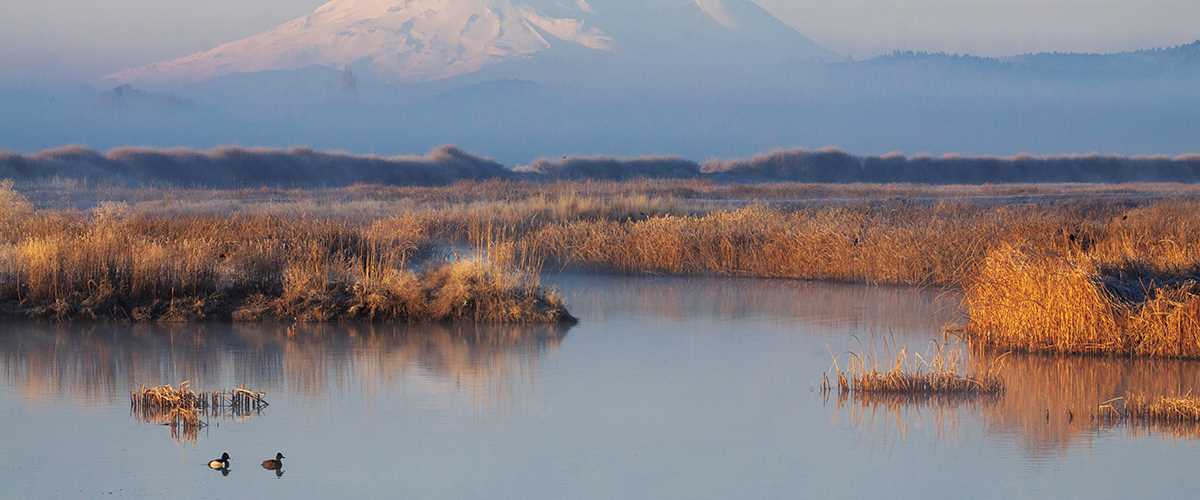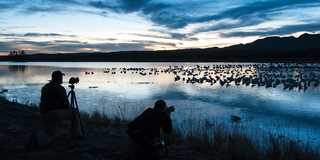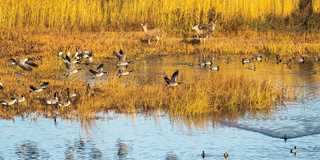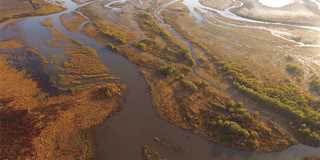Conserving these multipurpose habitats is important not only for waterfowl and other wildlife but also for people and the environment

By J. Dale James, Ph.D., and Ellen R. Herbert, Ph.D.
Wetlands are among the most valuable ecosystems on Earth, rivaling tropical rainforests in their biological productivity. Historically, wetland systems sustained civilizations by providing people with food and freshwater and protecting communities from flooding and storm surges. Prior to European settlement of the United States, the American wilderness included a remarkable abundance and diversity of wetlands, ranging from prairie potholes and bottomland hardwood forests to coastal marshes and playa lakes. Collectively, these habitats once encompassed more than 220 million acres in the lower 48 states alone.
Today most Americans value wetlands for their wildness, beauty, and the many ecological benefits they provide. But wetlands were not always held in such high regard. As more settlers arrived and populations expanded westward, wetlands were considered obstacles to progress. Between 1780 and 1980, more than half the wetlands in the United States were drained, filled, or significantly altered.
Rates of wetland conversion have slowed in recent decades, but these crucial habitats continue to be lost and degraded at alarming rates. Wetland loss is now widely recognized as a serious threat to the nation's environmental quality and economy. Moreover, there is a growing understanding that wetlands are in fact a crucial part of America's natural wealth, providing us all with valuable ecological goods and services worth billions of dollars a year. Best of all, we receive these benefits free of charge.

Photo © DAVIDSTIMAC.COM
Ducks Unlimited members are keenly aware of the importance of conserving wetlands for waterfowl, but many other species also benefit from DU's work. In fact, nearly half the bird species and two-thirds of the fish species in the United States rely on wetlands at some point during their lives. The U.S. Fish and Wildlife Service estimates that 101.6 million people—or 40 percent of the U.S. population age 16 and over—participate in fishing, hunting, bird-watching, or other forms of wildlife-associated recreation. These activities contribute more than $150 billion to the U.S. economy annually, representing nearly one percent of the nation's gross domestic product. In addition, wetlands help support 75 percent of all commercially caught fish and shellfish, the harvest of which contributes an estimated $1.2 trillion to our economy each year.
Another valuable societal benefit provided by wetlands is clean water. Known as "nature's kidneys," wetlands slow the flow of water across the landscape, allowing sediment, nutrients, and other particles to settle to the bottom. Those nutrients in turn fuel wetland productivity, supporting plants and invertebrates that provide food and shelter for waterfowl, fish, and other wildlife.
In some cases, wetlands can even replace or supplement traditional water treatment systems. For example, New York invested nearly $1.5 billion in the restoration and protection of wetlands and adjacent lands in the Hudson River valley, which has saved taxpayers between $3 billion and $8 billion in drinking water pretreatment costs. Other states have begun to restore wetlands specifically for the purpose of purifying fertilizer-rich farm runoff. Researchers estimate that restored wetlands can remove excess nitrogen fertilizer from farm runoff at an average cost of one dollar per pound of nitrogen, while traditional water treatment plants provide the same service at a cost of seven to 40 dollars per pound.
Wetlands also play a central role in recharging groundwater supplies. Inland wetlands capture precipitation and spring meltwater, releasing it slowly into streams and rivers. Some of this water finds its way into aquifers, replenishing groundwater used for drinking and irrigation. This function is especially important in semiarid regions such as the southern Great Plains, where playa lakes, other wetlands, and riverbeds are the only points of recharge for the underlying Ogallala Aquifer. Nationwide, nearly 44 percent of the U.S. population relies on groundwater for its drinking water supply.
In the nation's river corridors, wetlands such as bottomland hardwood forests absorb and store water, which helps prevent flooding in the surrounding watershed. Nationwide, wetlands provide an estimated $237 billion in water-flow regulation and flood-control services each year. Unfortunately, the ongoing drainage of wetlands using tile and ditches and the alteration of floodplains through the construction of levees and other development have led to increased inland flooding in the United States. A recent study concluded that flooding along the Mississippi River is becoming more frequent and severe due to wetland drainage and floodplain alteration.
Along America's coasts, wetlands serve as a natural buffer against hurricanes and other dangerous storms. Dense stands of marsh grass in coastal wetlands slow storm surges, reducing damage to communities and infrastructure. On the Gulf Coast, for example, economists estimate that the restoration of coastal wetlands could save communities nearly $20 billion in storm damage. Moreover, research has shown that restoring wetlands is nearly nine times more cost efficient in protecting coastal communities than building levees, breakwaters, and similar forms of manmade storm protection. As a result, federal agencies are now investing in natural infrastructure, like wetlands, to protect coastal communities, which will have the added benefit of providing productive habitat for wildlife and fisheries.
In recognition of the many important societal benefits that wetlands provide, Congress has passed a variety of laws to help conserve these vital habitats. Legislation such as the National Environmental Policy Act and the Clean Water Act include regulations that have slowed the rate of wetland loss in the United States. Other programs such as the Food Security Act and the Food, Agriculture, Conservation, and Trade Act established voluntary conservation easement programs that provide incentives for farmers and ranchers to restore and protect wetlands on agricultural landscapes. These laws also include "swampbuster" provisions that disqualify landowners who drain wetlands from receiving federal loans, crop insurance, and other taxpayer-supported benefits.

Photo © CHUCK & GRACE BARTLETT
North America's waterfowl populations depend on wetlands throughout their annual life cycle. Consequently, Ducks Unlimited focuses on restoring the types of wetlands that provide the resources necessary to sustain waterfowl throughout their vast continental ranges, from the breeding grounds to wintering areas and migration stopovers along the flyways. But Ducks Unlimited's conservation programs provide many environmental, social, and economic returns beyond their value to wildlife. For example, DU works to conserve prairie potholes on the northern Great Plains, wetlands in the Western Boreal Forest, bottomland hardwood forests in the Mississippi Alluvial Valley, flooded rice fields in the Central Valley of California, and coastal marshes along the Gulf of Mexico. All these habitats provide valuable ecological goods and services for people, such as improved water quality, protection from floods and storm surges, and groundwater recharge. In this way, DU helps support local and regional economies and the general well-being of people everywhere we work.
Ducks Unlimited employs various conservation strategies to help reverse the impacts of wetland loss across the continent. This work includes restoring drained and degraded wetlands as close to their natural state as possible. Wetland enhancement activities focus on improving specific functions of important waterfowl habitats. Wetland restoration and enhancement techniques often include the installation of water-control structures, levees, pumps, and other infrastructure to allow managers to regulate water levels at optimal depths for waterfowl and other wildlife. DU also protects intact wetlands and associated uplands by securing donated and purchased conservation easements from landowners, which preserves the conservation values of high-priority habitats in perpetuity. In addition, DU supports public policies that restore and enhance wetlands on public lands and provide incentives for farmers and ranchers to conserve crucial waterfowl habitats on agricultural lands.

Photo © CHRIS BENSON
For outdoorsmen and women, wetlands are places where we can hunt, fish, paddle a canoe, watch and photograph wildlife, and simply enjoy the beauty of nature. But these habitats also provide us with reliable supplies of clean water for drinking and irrigating crops and help protect us from natural disasters. As the leader in wetlands conservation, Ducks Unlimited plays a key role in ensuring that wetland systems remain intact and functional not only to sustain healthy waterfowl populations and our waterfowling traditions but also to provide a variety of other societal benefits. Through our science, public policy, and on-the-ground conservation programs, DU will continue to work tirelessly to conserve wetlands so that we can leave future generations with the many gifts that these vital natural habitats provide.
Dr. J. Dale James is director of conservation planning in Ducks Unlimited's Southern Region and Dr. Ellen Herbert is DU's ecosystem services scientist at its national headquarters in Memphis.

Photo © TRAVIS MUELLER, AVERY OUTDOORS
DU Joins Natural Infrastructure Initiative Steering Committee
In recognition of the value of its wetland conservation work, Ducks Unlimited was recently invited to be the newest member of the Natural Infrastructure Initiative Steering Committee. The Natural Infrastructure Initiative is a coalition of corporations and nonprofit organizations that advances awareness of and investment in natural infrastructure, such as wetlands, and outlines the economic and environmental benefits found in natural approaches to flood risk reduction, water quality improvement, and many other pressing infrastructure issues. Through this coalition, DU will help highlight the value of conserving wetlands and associated habitats for the benefit of people and wildlife.
Ducks Unlimited uses cookies to enhance your browsing experience, optimize site functionality, analyze traffic, and deliver personalized advertising through third parties. By continuing to use this site, you agree to our use of cookies. View Privacy Policy